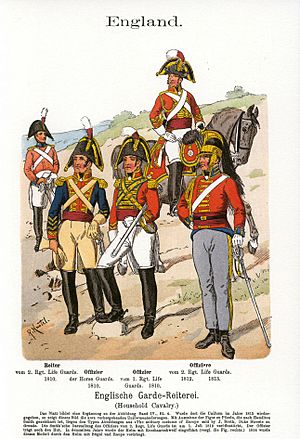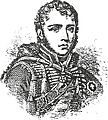Battle of Maguilla facts for kids
The Battle of Maguilla happened on June 11, 1812, during the Peninsular War. It was a fight between British and French cavalry (horse soldiers) near Maguilla, Spain. A British cavalry group, led by John Slade, attacked a similar-sized French group, led by François Antoine Lallemand.
At first, the British dragoons (a type of cavalry) won, scattering the French and capturing some of them. But the British soldiers got too excited and chased the French without keeping their formation. Suddenly, a small group of French reserve soldiers charged the messy British lines. The main French force then turned around and fought back. The tables turned, and the French chased the British until both sides' horses were too tired to continue.
This battle was part of a larger campaign in Extremadura, where an Allied army under Rowland Hill faced a French army under Jean-Baptiste Drouet, Comte d'Erlon. Even though the British lost this specific battle, Hill's main advance continued. The bigger Battle of Salamanca happened later, which forced the French to leave southern Spain.
Quick facts for kids Battle of Maguilla |
|||||||
|---|---|---|---|---|---|---|---|
| Part of the Peninsular War | |||||||
 British heavy dragoons wore a red coat and black bicorne hat at Maguilla, similar to the trooper at far left. The helmet was not adopted until 1813 |
|||||||
|
|||||||
| Belligerents | |||||||
| Commanders and leaders | |||||||
| Strength | |||||||
| 700 | 700 | ||||||
| Casualties and losses | |||||||
| 51 killed, wounded or captured | 48 killed or wounded 118 captured |
||||||
Contents
Why the Battle Happened
The Peninsular War was a big conflict in Spain and Portugal. It was part of the Napoleonic Wars, where Napoleon's French Empire fought against other European powers.
Spain in 1812
In 1812, Napoleon was getting ready to invade Russia. He left his brother, King Joseph Bonaparte, in charge of Spain. France had many soldiers in Spain, but they were spread out. Some were fighting in the south, and others were in the north.
The British and their allies, led by Wellington, had just captured the important fortress of Badajoz. This opened a way for them to move deeper into Spain.
Allied and French Forces
Wellington moved most of his army north to fight a French general named Auguste de Marmont. He left about 18,000 soldiers in the south under General Hill. Hill's job was to keep an eye on the French forces in the south, led by General d'Erlon.
Hill's army included British, Portuguese, and Spanish soldiers. D'Erlon's French army had about 12,000 men. Wellington wanted Hill to stop d'Erlon from sending help to Marmont in the north.
The Battle of Maguilla
On June 11, 1812, General Hill's army was moving forward. As part of this advance, a Spanish cavalry group and a British cavalry group, led by General Slade, were scouting ahead.
First Contact
Slade's British dragoons (horse soldiers) found French dragoons near Maguilla. The French, led by General François Antoine Lallemand, had about 700 soldiers. Slade also had about 700 dragoons from the 1st Royal Dragoon and 3rd Dragoon Guards Regiments.
Lallemand's men pulled back to the edge of Maguilla. Slade immediately ordered his soldiers to charge. The British dragoons broke through the French lines and captured about 100 prisoners.
The Reckless Chase
Instead of stopping to get their lines back in order, the British dragoons kept chasing the fleeing French. They galloped for several miles, each regiment trying to be the fastest. This made their formation very messy.
Suddenly, a hidden French squadron (a small group of cavalry) charged into the disorganized British. Seeing this, the main French force, which had been running, turned around and attacked the British. The British dragoons were now the ones running away.
The Retreat
The British fled for several miles, even though their officers tried to stop them. The chase finally ended near Valencia de las Torres, about 4 miles (6.4 km) from Maguilla. Both sides' horses were completely exhausted. Slade managed to get his remaining soldiers back into formation and pulled them back.
The British lost 22 killed, 26 wounded, and 118 captured. Many of those captured were also wounded. The French reported 51 killed and wounded. Most of the French soldiers captured at the start of the battle managed to escape during the British retreat.
What Happened Next
The Battle of Maguilla itself didn't change the overall campaign much. General d'Erlon, the French commander, retreated from Hill's advance. He told his commander, Marshal Jean de Dieu Soult, that he was facing a much larger Allied force.
French Reinforcements
Marshal Soult sent d'Erlon more soldiers, including an infantry division and a cavalry division. This brought d'Erlon's total force to about 18,000 soldiers. Soult wanted d'Erlon to force Hill into a big battle or at least stop him from sending troops to Wellington.
Hill's Withdrawal and Advance
When Hill heard about the French reinforcements, he pulled his army back to a strong position near the old battlefield of La Albuera. They dug in and waited for an attack. The two armies faced each other for about two weeks. The Allied soldiers had to deal with the smell of hundreds of unburied bodies from the previous year's battle at La Albuera.
On July 1, the French cavalry scouted the Allied position. Lallemand's cavalry group defeated a Spanish cavalry group, causing many losses. But d'Erlon decided that Hill's position was too strong to attack.
Hill then decided to advance again on July 2. He expected a battle, but the French kept retreating when their side was threatened. The armies ended up back in their original positions from before Hill's withdrawal.
End of the Campaign
Later, Marshal Soult received news that Marmont's army had been badly defeated at the Battle of Salamanca on August 12. This big Allied victory forced the French to leave Andalusia and Extremadura.
On August 26, Hill found d'Erlon's lines empty. The French had left the area. Hill didn't chase them because Wellington called him to join the main Allied army. Soon, the south of Spain was free from French control.
Images for kids





